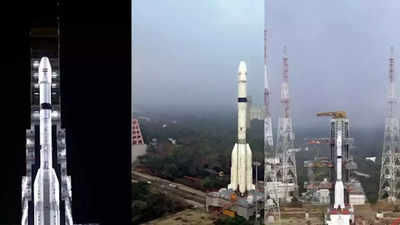- News
- Science News
- ISRO to launch 100th mission from Sriharikota: GSLV-F15 with NVS-02 satellite – Date, time, and where to watch
ISRO to launch 100th mission from Sriharikota: GSLV-F15 with NVS-02 satellite – Date, time, and where to watch
ISRO is set to launch its 100th rocket from Satish Dhawan Space Centre, marking a significant milestone. The GSLV-F15 will carry the NVS-02 satellite, part of India's NavIC system, enhancing regional navigation capabilities and reducing reliance on foreign systems like GPS. The launch is scheduled for January 29, 2025, and represents a major achievement in India's space exploration ambitions.
ISRO stands on the threshold of another big achievement in its journey of space exploration. GSLV-F15 from Satish Dhawan Space Centre at Sriharikota is ready to launch, which marks the launch of the 100th rocket from an Indian spaceport. It is once again a steady step and leadership by ISRO in the path toward greater capabilities in satellite navigation and regional positioning for India.
ISRO to launch GSLV-F15 with NVS-02 satellite
GSLV-F15 is the launch vehicle under the ISRO Geosynchronous Satellite Launch Vehicle program carrying the NVS-02 satellite. NVS-02 will be one of the constellations belonging to NavIC of India. It is an independent regional navigation satellite system developed by ISRO, providing reliable PVT services for users within India and its neighborhood. Improved accuracy and reliability of navigation service provision for civilian as well as military purposes would be achieved, and reliance on foreign satellite systems like GPS would be reduced.
GSLV-F15 is the 17th flight of the GSLV rocket series. It is an important milestone for India in space exploration. This is special because GSLV-F15 will have an indigenous cryogenic stage. The cryogenic engine is crucial to higher payload capacities and efficiency in satellite launches, and ISRO's success in developing its own cryogenic technology is a great achievement in its journey toward self-reliance in space technology.
ISRO’s launch of GSLV-F15: Date and time
GSLV-F15 is scheduled for launch on 29th January, 2025, at 6:23 AM IST from Satish Dhawan Space Centre, Sriharikota - An establishment almost of a haven for all of India's space exploration ventures. First and foremost, this is historic not because it would be the 100th rocket launching from that spaceport, but, the payload will ensure India is here to stay as a part of the global space community. GSLV-F15 is the 11th launch in this particular type of GSLV fitted with the cryogenic stage.
ISRO’s launch of GSLV-F15: Where to watch
The Indian Space Research Organisation will broadcast it live. This launch is available to enthusiasts as well as experts alike because the event will be covered live and hence allow viewing of when the satellite enters into orbit.
What is the NVS-02 satellite?
NVS-02 is the second of the new generation of navigation satellites developed under the NavIC system. The satellite has a mass of about 2,250 kilograms, which will be placed into GTO orbit following launch. The NavIC system, developed by ISRO, would be able to offer the navigation service in a relatively accurate manner covering the area not only within India but also extending 1,500 km beyond it. That would mean that the NavIC is all about providing uninterrupted, accurate navigation information to the users of that region. This would be a prime necessity for military use as well as civil use in transport and agriculture.
NavIC is a combination of seven satellites put together for the purpose of providing positioning data. The addition of NVS-02 increases the reliability of the system by expanding the coverage and creating the robustness level of the system against all environmental changes that might influence the reception of the signal.
Why is NVS-02 important?
The introduction of NVS-02 is very essential for several important reasons. Importantly, in the overall scenario of ISRO to develop the satellite-based navigation field, this part forms a valuable component. Current dependency of India towards many applications would be mostly available from foreign-originated systems like that of US - GPS. Reducing dependency by providing an Indian indigenous reliable secure regional navigation would be the primary need for NavIC.
The NVS-02 satellite will help various sectors of India like transportation, defense, and logistics. This satellite will help in proper tracking and guiding in transportation, track air and sea traffic efficiently, and will enhance the defense capabilities by having secure, local navigation to carry out military operations.
India's future space exploration
The successful launch of NVS-02 is going to pave the way for further missions and advancements in satellite technology. Given that India's space program is expected to go further in the near future, launching Rosalind Franklin rover to Mars in 2028; continuously developing navigation systems through satellites; and further cooperation with other international space agencies, it's ready to boom.
GSLV-F15 and the launch of the NVS-02 satellite mark an important milestone in the journey of India towards greater space independence and technological self-sufficiency. This would greatly help India enhance its contribution toward navigation but, at the same time, will clearly showcase ISRO's capability to perform complex missions with precision degrees of innovation. Such a mission will have far-reaching impacts on various sectors in India-a technological, defense, and industrial impetus that will be sustained long after these missions have been concluded.
Also Read | Did Mars once have a massive ocean? New study suggests ancient ocean in Martian clay mounds
End of Article
FOLLOW US ON SOCIAL MEDIA
Hot Picks
TOP TRENDING
Explore Every Corner
Across The Globe












